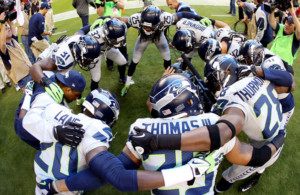Football season is starting up, and what better example of team building than watching two teams of 11 men each demonstrate not just physical prowess but their ability to communicate and react to a changing situation on the field?
 One of the most complicated plays on the offense is a handoff from the quarterback to one of the two running backs on the team. The team must do as much as possible to keep the defense from guessing what they’re about to do. In some cases, this means that even before the ball is snapped, the running backs are already running a complicated pattern behind the line of scrimmage, dashing to one side of the line, then to the other. They must time their patterns so that the running back who has been designated to carry the ball over the line of scrimmage meets the quarterback at the right moment to receive the ball. In the meantime, the offensive line is working to open a lane for the running back to dash through after he gets the ball.
One of the most complicated plays on the offense is a handoff from the quarterback to one of the two running backs on the team. The team must do as much as possible to keep the defense from guessing what they’re about to do. In some cases, this means that even before the ball is snapped, the running backs are already running a complicated pattern behind the line of scrimmage, dashing to one side of the line, then to the other. They must time their patterns so that the running back who has been designated to carry the ball over the line of scrimmage meets the quarterback at the right moment to receive the ball. In the meantime, the offensive line is working to open a lane for the running back to dash through after he gets the ball.
Missing that handoff is a real possibility—everything must be timed perfectly, without being disrupted by the defense. When the play goes off without a hitch, it is a thing of beauty to watch.
These complex plays require a team with strong cohesiveness whose members are highly skilled at their respective tasks. It’s not surprising that football teams spend weeks ahead of the season running the same drills over and over. They’re not just building skill, they’re gluing the team together.
A workplace team can also benefit greatly from strong cohesion. Knowing what each team member is responsible for and being confident that each person will come through with their part of a task, on time, really boosts trust in each other – and in turn, productivity.
Communication is a central part of accomplishing a complicated project and in building team cohesiveness. A quarterback gives physical signals to help the running backs time their movements correctly. Likewise, a team member can signal – verbally – when he or she is ready to start their part of a project, or if their assigned task is not quite complete.
It’s up to the team leader to make sure that members are communicating with each other and working smoothly together. That can be the difference between missing the mark on a deadline-sensitive project or accomplishing goals in a beautiful way.
 Excerpted from One Team, One Dream by Gregg Gregory
Excerpted from One Team, One Dream by Gregg Gregory
For more information, get your copy of Gregg’s book, One Team, One Dream today! Available in both print and electronic versions!
Bring Gregg to you!
Featured team development seminar – Synchronize Your Team


Leave A Comment